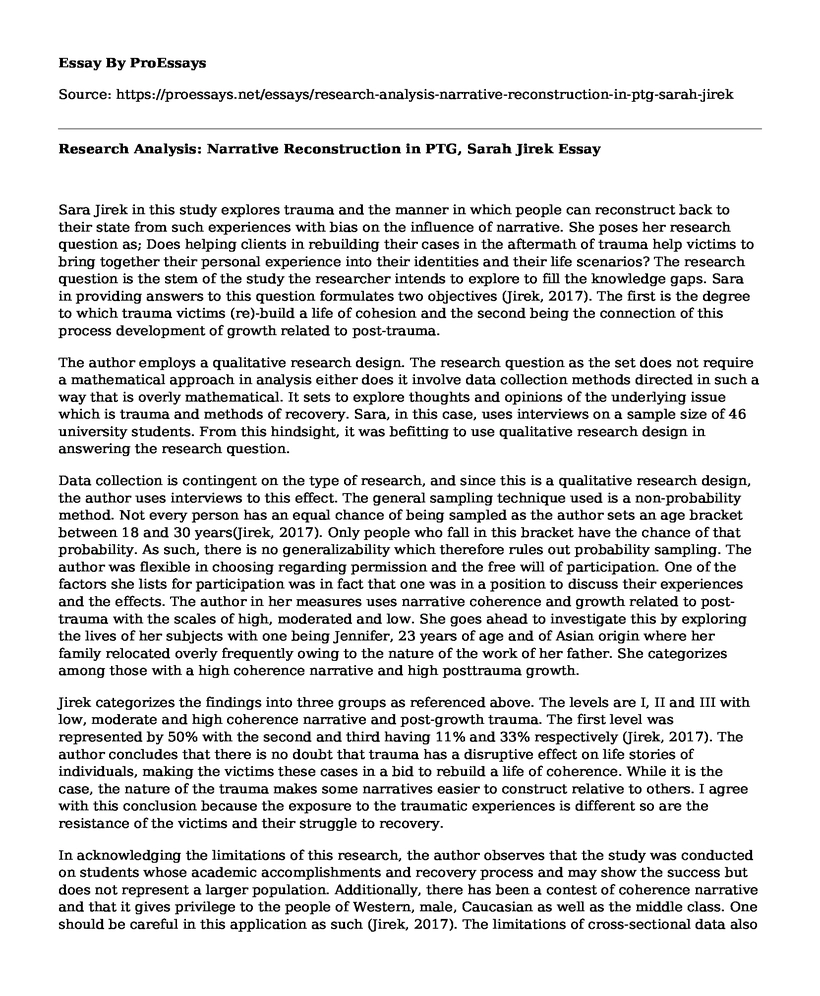Sara Jirek in this study explores trauma and the manner in which people can reconstruct back to their state from such experiences with bias on the influence of narrative. She poses her research question as; Does helping clients in rebuilding their cases in the aftermath of trauma help victims to bring together their personal experience into their identities and their life scenarios? The research question is the stem of the study the researcher intends to explore to fill the knowledge gaps. Sara in providing answers to this question formulates two objectives (Jirek, 2017). The first is the degree to which trauma victims (re)-build a life of cohesion and the second being the connection of this process development of growth related to post-trauma.
The author employs a qualitative research design. The research question as the set does not require a mathematical approach in analysis either does it involve data collection methods directed in such a way that is overly mathematical. It sets to explore thoughts and opinions of the underlying issue which is trauma and methods of recovery. Sara, in this case, uses interviews on a sample size of 46 university students. From this hindsight, it was befitting to use qualitative research design in answering the research question.
Data collection is contingent on the type of research, and since this is a qualitative research design, the author uses interviews to this effect. The general sampling technique used is a non-probability method. Not every person has an equal chance of being sampled as the author sets an age bracket between 18 and 30 years(Jirek, 2017). Only people who fall in this bracket have the chance of that probability. As such, there is no generalizability which therefore rules out probability sampling. The author was flexible in choosing regarding permission and the free will of participation. One of the factors she lists for participation was in fact that one was in a position to discuss their experiences and the effects. The author in her measures uses narrative coherence and growth related to post-trauma with the scales of high, moderated and low. She goes ahead to investigate this by exploring the lives of her subjects with one being Jennifer, 23 years of age and of Asian origin where her family relocated overly frequently owing to the nature of the work of her father. She categorizes among those with a high coherence narrative and high posttrauma growth.
Jirek categorizes the findings into three groups as referenced above. The levels are I, II and III with low, moderate and high coherence narrative and post-growth trauma. The first level was represented by 50% with the second and third having 11% and 33% respectively (Jirek, 2017). The author concludes that there is no doubt that trauma has a disruptive effect on life stories of individuals, making the victims these cases in a bid to rebuild a life of coherence. While it is the case, the nature of the trauma makes some narratives easier to construct relative to others. I agree with this conclusion because the exposure to the traumatic experiences is different so are the resistance of the victims and their struggle to recovery.
In acknowledging the limitations of this research, the author observes that the study was conducted on students whose academic accomplishments and recovery process and may show the success but does not represent a larger population. Additionally, there has been a contest of coherence narrative and that it gives privilege to the people of Western, male, Caucasian as well as the middle class. One should be careful in this application as such (Jirek, 2017). The limitations of cross-sectional data also make it difficult for the study to certainly demonstrate that the tree levels are progressive stages of post-trauma change.
The author suggests and recommends further studies on people who are older and uneducated in addressing the first limitation and on non-western, non- Caucasian and less privileged social class in establishing the relationship between coherence of narrative and PTG about the second limitation.
References
Sarah L. Jirek (2017): Narrative reconstruction and post-traumatic growth among trauma survivors; The Importance of Narrative in Social Work Research and Practice.Qualitative Social Work Vol. 16(2) 166-188.
Cite this page
Research Analysis: Narrative Reconstruction in PTG, Sarah Jirek. (2022, Jun 06). Retrieved from https://proessays.net/essays/research-analysis-narrative-reconstruction-in-ptg-sarah-jirek
If you are the original author of this essay and no longer wish to have it published on the ProEssays website, please click below to request its removal:
- Parental Love
- Essay Sample: Gangs in Trenton, New Jersey
- Five Counselling Models of Integrating Spirituality Essay Example
- Essay Sample on Sports Betting Legalizing: Impact on Gambling Addiction
- The Dilemma of Medication for Severely Depressed Patient: Case Study
- ABA: Helping Autistic Kids Develop Social Skills - Essay Sample
- Essay on Domestic Violence: A Serious Problem for Employees and Organizations







